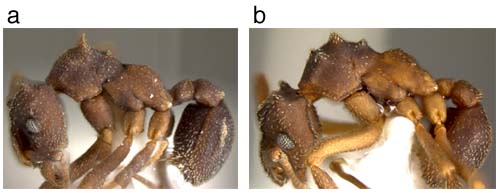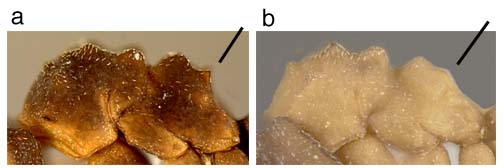
| Genus List | Genus overview |Species List |
10a. Mandibles with 6 or 7 teeth, gradually diminishing in size toward base; preocular carina extending all the way back to the vertex margin, forming ventral border of antennal scrobe (very rare species): 20
10b. Mandibles with 5 teeth; preocular carina variable: 50
20a. Propodeum with spines; node of petiole bidentate; paraclypeal teeth small; mandible with 6 teeth: andersoni
20b. Propodeum lacking spines; node of petiole a single convexity, not bidentate; paraclypeal teeth large and spiniform; mandible with 7 teeth: snellingi
50a. Preocular carina extending posteriorly, not curving mesad toward frontal carina; antennal scrobe more or less well defined; first gastral tergite with or without two prominent longitudinal carinae: 60
50b. Preocular carina curving mesad toward frontal carina; antennal scrobe poorly defined; first gastral tergite lacking pair of prominent longitudinal carinae: 80

60a. Disk of first gastral tergite with two strong longitudinal carinae; posterolateral vertex margins obtuse, not strongly projecting: costatus
60b. Disk of first gastral tergite smooth, lacking longitudinal carinae; posterolateral vertex margins acute and strongly projecting: 70

70a. Mesosomal dorsum forming a continuous convexity, lacking tubercles, metanotal groove not impressed; size relatively small: c.f. muelleri
70b. Mesosomal dorsum with blunt mesonotal tubercles; metanotal groove impressed; size relatively longer: c.f. longiscapus

80a. Lateral vertex margins produced as acute teeth that project posterolaterally: 90
80b. Lateral vertex margins either not produced as acute teeth or forming short acute teeth that project posteriorly: 100

90a. Pronotum lacking tubercles; anterior mesonotal tubercles very large; overall size large: cornutus
90b. Pronotum with lateral and median tubercles: salvini

100a. Lateral vertex margins forming blunt angles, not produced as acute teeth: 110
100b. Lateral vertex margins forming acute teeth that project posteriorly: 120

110a. Pronotum with median tubercles: rimosus
110b. Pronotum lacking median tubercles: peltatus

120a. Propodeum with distinct spines: dixus
120b. Propodeum lacking spines: major

Page author:
John T. Longino, The Evergreen State College, Olympia WA 98505 USA.longinoj@evergreen.edu